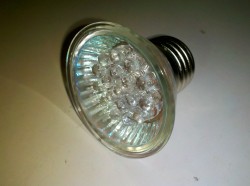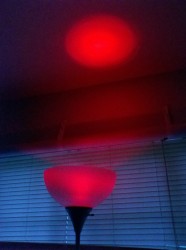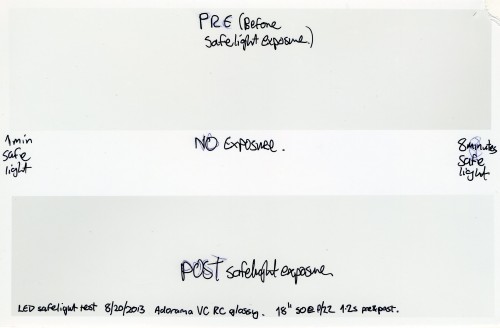A few weeks ago I ordered an 18 LED red lamp from DealExtreme, to use as a safelight. At under $5 with free shipping, it was a screamin’ deal and significantly cheaper than the various dedicated safelights which routinely come up on Ebay. It screws into a regular light socket so no special stuff needed to make it work. Had a bit of a wait for it to arrive, but since there were lots of other odds and ends I also needed, this wasn’t an issue. And hey, free shipping from China? I can’t even get free shipping from NYC or LA on most photographic items, especially not ones for under a fiver.
 It arrived intact despite some frankly shonky packaging, and lit up as expected. It works with the enlarging timer I picked up, so it can switch off automatically when the enlarger is on. It doesn’t put out a huge amount of light, but it’s enough to work by without having to feel around in the darkness.
It arrived intact despite some frankly shonky packaging, and lit up as expected. It works with the enlarging timer I picked up, so it can switch off automatically when the enlarger is on. It doesn’t put out a huge amount of light, but it’s enough to work by without having to feel around in the darkness.
The big question, of course, was: is it safe? LED lighting offers the promise of a very narrow band of frequency present in the light, with no light emitted which the paper is sensitive to. However, not all LEDs are pure and some impure “red” units can emit down into the green and even blue, enough to cause fogging. I’d read on APUG that this particular unit is quite safe, but it’s always prudent to make sure.
 Luckily, both Kodak and Ilford publish methods for testing safelights. I went with a modification of the Ilford method for my testing.
Luckily, both Kodak and Ilford publish methods for testing safelights. I went with a modification of the Ilford method for my testing.
The first step, without any safelighting on, was to identify an exposure time and enlarger settings which would cause a very light gray to be developed out on the paper. I ran a simple test strip with 0.2 second intervals and found 1.2 seconds was about right.
Having found a time for light gray, I then exposed about 1/3 of the paper for this time. The corner was torn off to give me a point of reference for later, when a second exposure would be made on a different part of the paper.
Next, the paper was placed directly under the safelight, which is in a floor-standing lamp bounced into the ceiling. This is a worse-than-worst-case position in my darkroom, closer to the safelight than I would normally be working. The entire page received a minute of exposure to red LED light, with 1 inch covered up every minute thereafter; the final inch of paper received a full 8 minutes under the light! Far longer than it normally would spend, and at a higher intensity too.
Finally, back in full darkness, another third of the paper was given 1.2 seconds under the enlarger, and then a normal develop-stop-fix-wash took place.
The test as performed does three things. Firstly, it tests for fogging on entirely unexposed areas. If bands of increasing gray show up across the page, the safelight wasn’t safe for that exposure time. Secondly, it tests the effect of safelight exposure before the image itself is exposed. Finally, it tests the effect of safelight exposure on an exposed latent image, which will show darkening under unsafe light before the unexposed paper has received enough light to itself start fogging.
The result?
Yes, it is safe. All the way to 8 minutes, no fogging of the base or darkening of exposed areas whatsoever. I can also see that there’s a little light falloff toward the corners (the gray area is not quite uniformly gray, it lightens a little toward what was the top left corner during the enlarger exposure. However, I doubt that will show up in normal use, as it isn’t a major difference. The paper itself is much whiter and uniform than the scan makes it appear, in fact it’s pure unexposed white in the unexposed areas; clearly I need to work on my scanning technique for prints!
The important thing to note is that no vertical banding shows up as you move from left to right, either in the unexposed parts or in the two sections exposed to light gray.
I’m now tempted to add a second one of these lights nearer the enlarger, and maybe move the current light to be closer to the developer tray. If I add a second light I’ll re-do the test, but I’m sure it’ll remain 100% safe.
The next step in my darkroom odyssey will be my first actual print! Watch this space…
